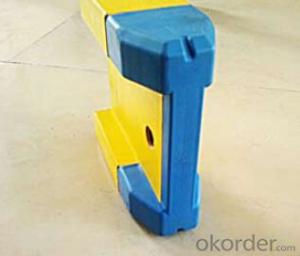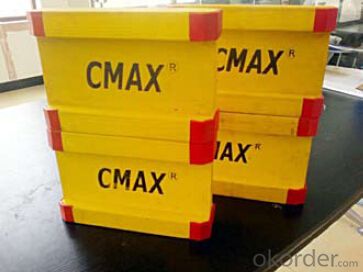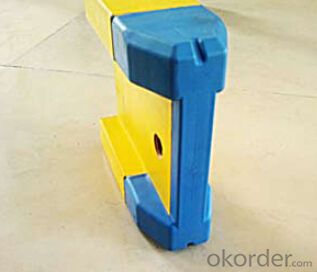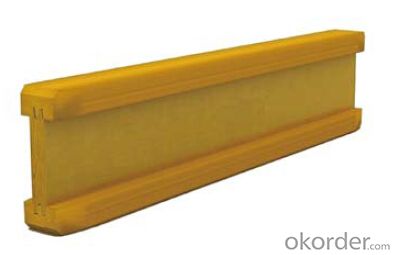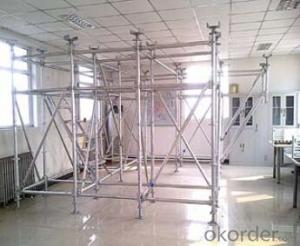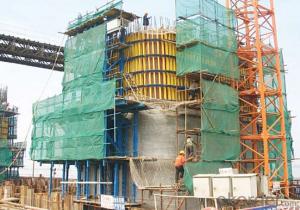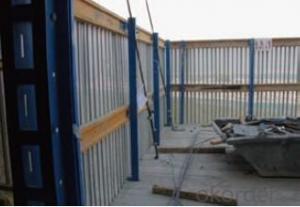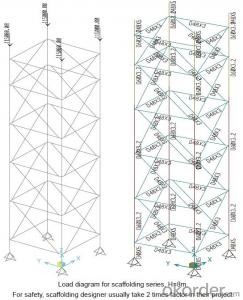Timber-beam Formwork for building Construction
- Loading Port:
- Tianjin
- Payment Terms:
- TT OR LC
- Min Order Qty:
- 50 m²
- Supply Capability:
- 1000 m²/month
OKorder Service Pledge
Quality Product, Order Online Tracking, Timely Delivery
OKorder Financial Service
Credit Rating, Credit Services, Credit Purchasing
You Might Also Like
Characteristics:
◆ Standardized production lines.
Supply capability: 3000m/day, Lmax = 6600mm.
◆ Finger jointing of the flange and web, the strength of timber beam is highly improved.
Max. shearing force failure load:40KN
◆ Well treated to prevent from water penetration or erosion, so the service life maximally
extended.
Normally, CNBM timber beam H20 can be used for 4 to 5 years, the exact using time would
depend on maintenance & storage.
◆ Robust caps at the end of the girders protect against damages.
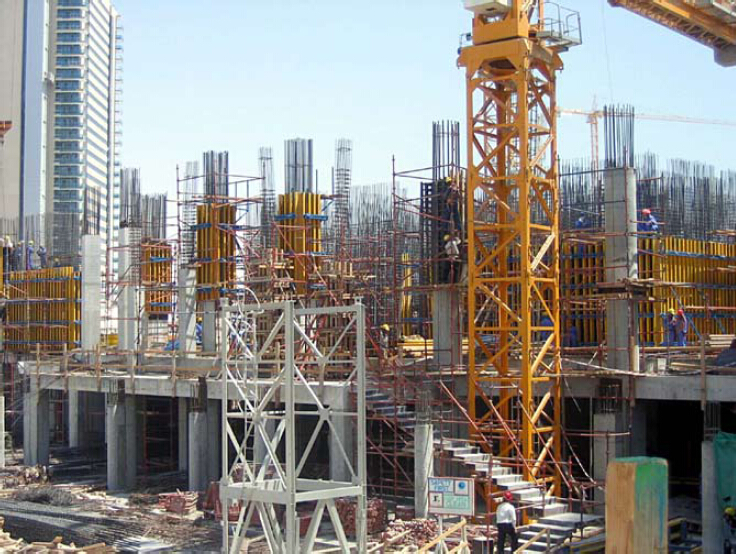
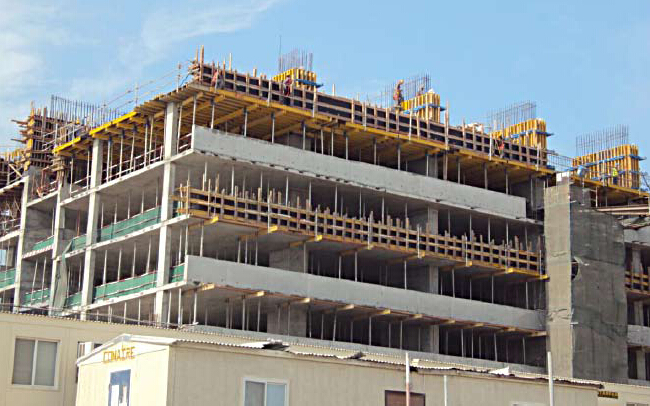
- Q: Are there any specific maintenance requirements for steel formwork systems?
- Steel formwork systems have specific maintenance requirements that must be followed. These systems are commonly used in construction to create temporary molds or frameworks for pouring concrete. While they are designed to be durable and long-lasting, regular maintenance is crucial to ensure their proper functioning and longevity. To begin, it is important to regularly clean and remove any debris or concrete residue that may accumulate on the surfaces of the steel formwork systems. This can be achieved by utilizing a wire brush or high-pressure water jet to eliminate any hardened concrete or build-up. By cleaning the formwork, the accumulation of materials that could impact the quality and appearance of future concrete pours can be avoided. Furthermore, it is essential to inspect the steel formwork system for any signs of damage or wear. This involves checking for cracks, dents, or rust on the steel components. In the event that any damage is identified, it should be promptly repaired in order to prevent further deterioration and to uphold the structural integrity of the formwork. Another maintenance requirement is to ensure that the moving parts of the steel formwork system are properly lubricated. This includes hinges, locks, and adjustable parts that allow for effortless assembly and disassembly. Lubrication aids in preventing corrosion, promotes smooth operation, and extends the lifespan of the formwork system. In addition, it is necessary to regularly inspect the alignment and stability of the formwork system. This guarantees that the formwork remains level and securely in place during concrete pouring. Any misalignment or instability should be addressed immediately to prevent accidents or structural issues throughout the construction process. Overall, proactive maintenance of steel formwork systems is vital to ensure their proper functioning, durability, and safety. Regular cleaning, inspection, repair, and lubrication are key components in maintaining the quality and longevity of these systems, ultimately contributing to the success of construction projects.
- Q: What are the different types of accessories used with steel formwork?
- Some different types of accessories used with steel formwork include wedges, clamps, connectors, form ties, formwork braces, pins, and formwork release agents.
- Q: What are the different types of sealing systems used with steel formwork?
- There are primarily three types of sealing systems used with steel formwork: mechanical seals, chemical seals, and hydraulic seals. Mechanical seals involve using gaskets, rubber strips, or other mechanical devices to create a tight seal between the formwork components. Chemical seals involve applying chemical sealants or adhesives to fill any gaps or joints in the formwork, ensuring a watertight seal. Hydraulic seals use hydraulic pressure to create a seal, typically achieved through the use of specialized hydraulic clamps or seals. Each sealing system has its advantages and disadvantages depending on the specific requirements of the construction project.
- Q: What are the maintenance requirements for steel formwork?
- Regular cleaning and inspection are the key maintenance requirements for steel formwork. After each use, it is important to clean the formwork to remove any concrete residue, dirt, or debris. This can be achieved by using water and a mild detergent or, for tougher stains, a high-pressure washer can be employed. Additionally, it is crucial to inspect the formwork for signs of wear, damage, or corrosion. Prior to and after each use, a thorough examination should be conducted to ensure the structural integrity of the formwork. Any areas affected by rust or corrosion should be promptly treated by cleaning, sanding, and applying a rust inhibitor or paint to prevent further deterioration. Furthermore, it is necessary to regularly check the joints, connections, and fasteners of the formwork to ensure they are secure and functioning properly. Any loose or damaged components should be repaired or replaced as needed. Storage also plays a vital role in maintenance. To prevent rusting and corrosion, the formwork should be stored in a dry and well-ventilated area. It is recommended to stack the formwork correctly, leaving enough space between each piece to prevent deformation and promote air circulation. Lastly, it is essential to adhere to the manufacturer's instructions and recommendations for maintenance and care. This includes using the formwork within its designated load-bearing capacity, avoiding excessive impact or rough handling, and following any specific maintenance guidelines provided. By adhering to these maintenance requirements, the steel formwork can be maintained in optimal condition, ensuring its durability, reliability, and longevity for future construction projects.
- Q: Can steel formwork be used for both above-grade and below-grade walls?
- Steel formwork is a versatile construction tool that can be utilized for both above-grade and below-grade walls. Its adaptability allows for its use in various construction applications, encompassing both above-grade and below-grade walls. With its robustness and resilience, it is well-suited to endure the weight and pressure exerted by the concrete employed in these walls. Furthermore, the ease with which steel formwork can be assembled and disassembled facilitates efficient construction procedures for both wall types. Be it for basement walls or exterior walls above ground, steel formwork guarantees the essential support and shape for effective concrete pouring, ultimately yielding enduring and sturdy structures.
- Q: Is steel formwork more durable than other types of formwork?
- Steel formwork is indeed more durable than other types of formwork. Steel is a strong and sturdy material that can withstand heavy loads and high pressures. It is highly resistant to wear and tear, making it ideal for construction projects that require repetitive use of formwork. Unlike other materials such as wood or plastic, steel formwork does not warp, crack, or deteriorate easily over time. This durability ensures that steel formwork can be used for multiple concrete pours, reducing the need for frequent replacements and saving costs in the long run. Additionally, steel formwork is fire-resistant, which further enhances its durability and safety features. Overall, steel formwork offers superior durability compared to other types of formwork and is a reliable choice for construction projects.
- Q: Can steel formwork be used in areas with limited construction space or tight site constraints?
- Yes, steel formwork can be used in areas with limited construction space or tight site constraints. Steel formwork is known for its versatility and adaptability, making it suitable for various construction projects, including those with limited space. One of the main advantages of using steel formwork in these situations is its strength and durability. Steel formwork can withstand high pressure and heavy loads, allowing it to be used in confined areas without compromising its structural integrity. This makes it an ideal choice for areas with limited construction space or tight site constraints. Furthermore, steel formwork is highly flexible and can be easily adjusted or modified to fit the available space. It can be customized to different shapes and sizes, allowing it to be used in complex or irregularly shaped areas. This adaptability makes steel formwork a practical solution for construction projects with limited space. In addition, steel formwork is reusable and can be dismantled and reassembled in different locations. This feature is particularly useful in areas with tight site constraints, as it allows the formwork to be easily moved and reused in different parts of the construction site. This not only saves time and effort but also reduces the need for additional formwork materials. Overall, steel formwork is a suitable choice for areas with limited construction space or tight site constraints. Its strength, adaptability, and reusability make it a practical solution for various construction projects, ensuring efficient and effective use of the available space.
- Q: What are the common challenges faced during steel formwork transportation?
- During steel formwork transportation, there are several common challenges that may arise. One of the main challenges is the weight and size of the steel formwork. Steel formwork can be heavy and bulky, making it difficult to transport and handle. This can require special equipment and vehicles to safely transport the formwork to the desired location. Another challenge is the potential for damage or deformation during transportation. Steel formwork needs to be transported in a way that prevents any bending, twisting, or scratching. Improper handling or inadequate securing of the formwork can lead to damage, which may affect its performance and durability. The logistics of transportation can also be a challenge. Coordinating the delivery of steel formwork to construction sites can be complex, especially when multiple projects are ongoing simultaneously. Ensuring that the formwork arrives on time and in the correct quantities requires careful planning and coordination. Furthermore, the terrain and road conditions can pose challenges during transportation. If the construction site is located in a remote or difficult-to-access area, the transportation of steel formwork can be more challenging. Poor road conditions, narrow access roads, or steep inclines may require additional measures to ensure safe transportation. Lastly, safety considerations are paramount during steel formwork transportation. The weight and size of the formwork can pose risks to the personnel involved in loading, unloading, and securing the formwork. It is essential to follow proper safety protocols and provide appropriate training to the workers involved to minimize the risk of accidents or injuries. Overall, the common challenges faced during steel formwork transportation include the weight and size of the formwork, potential for damage or deformation, logistics of delivery, terrain and road conditions, and safety considerations. By addressing these challenges effectively, the transportation process can be executed smoothly, ensuring the timely and safe delivery of steel formwork to construction sites.
- Q: What are the different types of reinforcements used in steel formwork?
- Steel formwork utilizes various types of reinforcements, each possessing distinctive qualities and advantages. 1. Rebars, also known as steel bars, are the most commonly employed reinforcement in steel formwork. Crafted from carbon steel, these bars are obtainable in a range of sizes and shapes. They confer strength and stability to the formwork structure, enabling it to withstand the load and pressure exerted during concrete pouring. 2. Steel mesh, comprising interconnected steel wires arranged in a grid pattern, constitutes an additional reinforcement employed in steel formwork. It enhances strength and thwarts cracking or failure of the concrete due to shrinkage or temperature fluctuations. Steel mesh finds common application in large-scale construction endeavors necessitating extensive reinforcement. 3. Steel fibers, discretely short lengths of steel integrated into the concrete mix, augment its structural properties. These fibers enhance the concrete's tensile strength and ductility, reducing the requirement for supplementary reinforcement. Particularly advantageous in areas subject to heavy loads or dynamic forces, such as industrial floors or pavements. 4. Steel plates, flat rectangular sheets composed of steel, reinforce specific regions of the formwork. They are frequently deployed to bolster corners, joints, or areas necessitating additional support. Steel plates are versatile and readily customizable to accommodate desired shapes or sizes. 5. Steel beams, structural elements employed to support the formwork and evenly distribute loads. They confer stability and rigidity to the formwork structure, ensuring its integrity during the concrete pouring process. Steel beams are available in diverse shapes and sizes, including I-beams, H-beams, and U-beams, contingent on project-specific requirements. Ultimately, the utilization of diverse reinforcement types in steel formwork guarantees the strength, durability, and stability of the structure. The selection of reinforcement hinges upon factors such as load-bearing capacity, anticipated forces, and project-specific needs.
- Q: Can steel formwork be used for complex geometric designs?
- Yes, steel formwork can be used for complex geometric designs. Steel is a versatile material that can be easily shaped and molded into various intricate forms, making it suitable for complex geometric designs. Steel formwork allows for precise and accurate construction, ensuring that the desired shape and dimensions of the design are achieved. Additionally, the strength and durability of steel make it suitable for supporting the weight and pressure exerted during the concrete pouring process. This makes steel formwork a reliable choice for creating complex geometric designs in construction projects.
Send your message to us
Timber-beam Formwork for building Construction
- Loading Port:
- Tianjin
- Payment Terms:
- TT OR LC
- Min Order Qty:
- 50 m²
- Supply Capability:
- 1000 m²/month
OKorder Service Pledge
Quality Product, Order Online Tracking, Timely Delivery
OKorder Financial Service
Credit Rating, Credit Services, Credit Purchasing
Similar products
Hot products
Hot Searches

